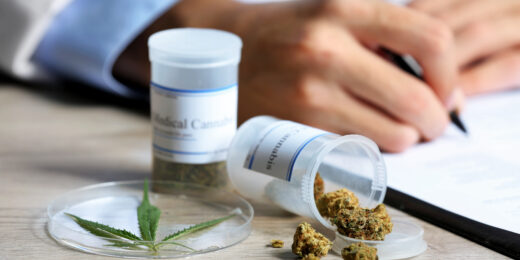In Kerrie Chabot's leadership classes at Hopkins Middle School in Fremont, Calif., students like Ishita Nalla and Soha Porwal learn to teach drug-education lessons that grab their peers' attention.
For instance, to get other middle schoolers to take note of the dangers of smoking, they might employ icky facts about phlegm.
"I think a really shocking piece of evidence is how much phlegm is coughed up when you have COPD, as well as how much tar builds up in a lung," Soha said of the condition chronic obstructive pulmonary disease.
To illustrate, Soha and Ishita, both 8th graders who took Chabot's class last year, would pass around a bottle showing the volume of phlegm coughed up in a day by a COPD patient. The hands-on demos got strong -- and occasionally goofy -- responses.
"People used to go around trying to open it, or would be like, 'Is it real? Did someone cough this up?'" Ishita said. "We would be fun about it, 'No, it's not real.' And we would try to keep it informative and keep the lesson on track."
We would try to keep it informative and keep the lesson on track.
Ishita Nalla
The lessons Chabot's students teach are built on drug education curricula from Stanford Medicine's Research and Education to empower Adolescents and young adults to Choose Health, or REACH, lab. And while passing around faux phlegm technically goes against today's best practices -- scare tactics have proven ineffective -- the fact teens conceived of that visual aid to share with their peers shows they are willing to engage in the subject matter when the talk is real.
The toolkits and related drug prevention and intervention curriculums are available for free and widely used at elementary, middle and high schools across the United States, and the globe. The materials are designed, tested and disseminated by a team run by adolescent substance use and abuse expert Bonnie Halpern-Felsher, PhD, with the goal of giving young people knowledge, safety messages, and skills that will help them stay safe from all substances, including the most deadly, fentanyl.

"To help teens make good decisions, it's important to give them information about how each substance affects their bodies, their brains and their development," said Halpern-Felsher, a developmental psychologist and professor of pediatrics at Stanford Medicine.
Today, youth who use drugs face risks not experienced by prior generations, she noted. Accidental fentanyl overdose from contaminated pills tops her list of concerns, as fentanyl and related synthetic opioids continue to kill more than 150 people a day across the country. Most teens who die from fentanyl poisoning are taking pills they believe to be safe, she said.
She's also worried about the proliferation of misinformation about addictive substances on social media, where, for instance, e-cigarette companies advertise to teens with targeted, sophisticated messaging about their vaping products that their parents may never see. In this climate, it's important to connect with youth in ways that give them useful knowledge to protect their own safety, Halpern-Felsher said. The uninformative, fear-based "Just Say No" drug education that parents of today's adolescents experienced when they were students in the 1980s and 90s aren't adequate.
"The reason 'Just Say No' doesn't work is you only tell people 'Don't do it,'" Halpern-Felsher said. "And the problem is that if and when they encounter drugs, they're ill equipped to know what to do and how to stay safe."
Emphasis on safety
Over the last decade, Halpern-Felsher's team has developed toolkits to educate youth about tobacco, including e-cigarettes, and cannabis. In the last year they have also greatly revised and expanded a preexisting curriculum that goes beyond the risks of tobacco or cannabis use to explain the potential harms of all drugs including alcohol, opioids, psychedelics and other drugs.
The team also recently launched a lesson specifically covering fentanyl and opioid awareness and overdose prevention. The Stanford Medicine team offers regular training events for teachers to help them learn to deploy each package of lessons.
The drug education lessons, available for free at the REACH lab's website, explain many substances young people encounter, including tobacco, cannabis, alcohol, misused prescription medications and several illicit drugs. There are lessons for elementary, middle and high school students. To date, the lessons have been used by over 20,000 teachers around the country and have reached over 3 million students.

All the education uses a harm reduction approach, combining messages about the risks of substance use with information that can keep teens safer if they choose to use drugs, or if their peers are using.
Some people worry about harm reduction because they believe it promotes drug use, Halpern-Felsher said. But the broader concept behind harm reduction is to take a realistic, fact-based approach to averting recreational drug use, and to reducing its risks among those who decide to use -- a combination that can help teens.
"The most effective way to reduce harm is not to use these substances at all," Halpern-Felsher said, adding that the toolkits make this clear, but also acknowledge that some teens will engage with illicit substances, and many more will be offered them in social situations. Instead of fear-based messages, the REACH approach is to explain how different drugs affect the body and brain, why some people use them, what the risks are, how teens may be especially vulnerable, and then offer concrete steps to stay safe if one uses.
"It's all about knowledge and empowerment, making sure young people understand what the drugs do, and their perceived and real risks and benefits," Halpern-Felsher said.
The lessons are interactive, giving kids opportunities to practice real-life situations, such as role-playing how they might decline a drug offer, or practicing healthy coping techniques to manage stress without substance use. The lessons also cover how tobacco marketing targets teens, and how the adolescent brain is more susceptible to addiction than the adult brain.
Although teaching teens how and why to avoid drug use is the goal, the curriculum also includes information aimed at those who choose to use.
"We know that 10-30% of adolescents are using tobacco, e-cigarettes, cannabis and other drugs," Halpern-Felsher said. Harm reduction includes tools to help them cut back or stop, and teaches safety measures to reduce risk of drug use. This includes planning ahead to avoid drinking and driving and how to administer Narcan to counteract an opioid overdose.
Digging in on substances
Teacher Jill Bertuccelli uses the REACH curricula in high school health classes at Vineyard Alternative School in Livermore, Calif. She also runs the school's tobacco use prevention education club, in which students can become peer educators.
"This curriculum is inclusive of every type of learner," she said, noting that it connects both with kids who are academically oriented and those who aren't.
Stanford's educational program sparks important conversations in her classes, Bertuccelli said. For instance, she said, "My students are always surprised by the amount of chemicals in e-cigarettes. So many times, they think they're just breathing flavor and water, and they're taken aback to learn that e-cigarettes are not a safer alternative to smoking."
My students are always surprised by the amount of chemicals in e-cigarettes. They think they're just breathing flavor and water, and they're taken aback to learn that e-cigarettes are not a safer alternative to smoking.
Bonnie Halpern-Felsher
Because many of Bertuccelli's students have tried cannabis products, that curriculum gets them talking. The lessons address facts about cannabis and mental health, including its role in potentiating conditions such as depression, anxiety, obsessive-compulsive disorder and psychosis in at-risk individuals.
"There's give and take on why cannabis is not safe to use, regardless of what they have been told," Bertuccelli said, adding that some teens even hear pro-cannabis messages from their parents.
Bertuccelli's students also like the segments focused on making healthy decisions, she said. One lesson, on mindfulness practice, guides students through meditation and box breathing -- substance use alternatives to coping with anxiety and stress.
"Giving people the skill to have control over their own thoughts and be mindful is huge in terms of prevention and cessation," Bertuccelli said.
The importance of information
Halpern-Felsher's team continues to look for ways to strengthen its educational offerings and broaden the audience.
To add to the existing evidence base behind the materials, they are conducting scientific studies to track the effects of the lessons on students, using before-and-after surveys to measure changes in students' attitudes and knowledge about drugs, and applying the findings to continue to fine-tune their materials.
They have also worked to engage many different groups of teens -- for instance, by including information on how tobacco marketing specifically targets certain groups, including young people of color and those who identify as LGBTQ. They have translated some of their curricula into Spanish and are working on translations into other languages, have created a curriculum specific to young people in Hawaii, and are building curricula specifically for LGBTQ+ and Native American youth.
More on youth substance use
- It's not 'just cannabis,' Stanford Medicine expert warns
- Whack-a-mole vaping policies do not protect youth, Stanford Medicine study shows
- Young adults don't know what's in nicotine products they vape
They're also working to increase awareness of risks such as fentanyl contamination in the recreational drug supply, Halpern-Felsher said. Many overdoses happen to young people who don't fit the stereotype of kid who uses drugs, she noted. Rather, victims may be teens who were in pain or depressed and thought a pill purchased from a peer or online would help, not realizing it was contaminated with fentanyl. Informing teens about how to reduce the risks is important, she said.
"The message -- both around fentanyl and with all forms of substance use -- is that we need to have honest, scientifically based conversations with children, adolescents and young adults," she said. "If we don't, they're not armed with the information they need to help them make healthy decisions."
Image: Ground Picture






